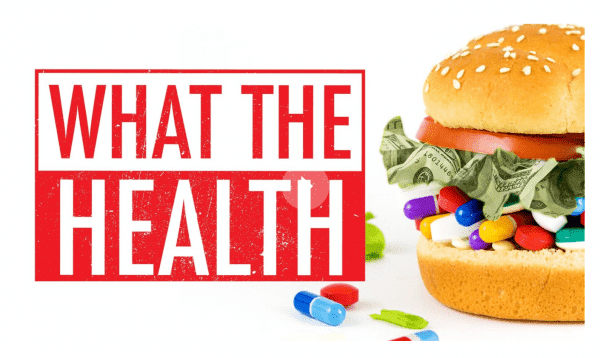
There’s a sensational documentary out on Netflix that seems to have a lot of people talking about going vegan.
In the spirit of so many food documentaries and diet books that have come before, What the Health promises us there is one healthy way to eat. And it involves cutting all animal products from our diet.
Meat, fish, poultry, and dairy are fattening us up, giving us cancer and Type-2 diabetes, and poisoning us with toxins, Kip Andersen, the film’s co-director and star, tells us.
Reflecting on a youth spent inhaling hot dogs and cold cuts, he asks, “Was this like I had essentially been smoking my whole childhood?”
No, Kip, not really.

To be sure, Andersen and co-director Keegan Kuhn’s intention was to explain the link between diet and disease and help Americans make healthier food choices. And there’s no doubt we are in the midst of obesity, diabetes, and heart disease epidemics driven in part by the kinds of food we eat in the quantities in which we eat them.
But Andersen’s film fails on several accounts, and cranks the food fear sirens to irresponsibly high levels. He mischaracterizes and overstates what we know about how particular foods drive disease, by offering a narrow view of the science with cherry-picked studies to support his views. He also seeks out a slew of vegan and animal rights–friendly health professionals rather than a more balanced roster of experts, and engages in silly gotcha journalism to suggest organizations like the American Diabetes Association intentionally hide the truth about diet.
Most of us could stand to eat more fruits and vegetables and less meat and dairy, and a plant-based diet is a healthy choice for many people. But with messages like “drinking milk causes cancer” or “eating eggs is as bad as smoking cigarettes,” this film isn’t going to right our health problems. It confuses what’s known in science and obscures the truths of nutrition that could actually help us live healthier lives.
What the Health cherry-picks and misreports studies to make the case for veganism
What the Health is part of a genre of food documentaries (and diet books) that selectively analyze nutrition research to demonize particular foods and praise a particular diet. In this case, Andersen cherry-picks studies about nutrition and often exaggerates their findings or reports them out of context, to drive home his case for veganism. Let’s run through a few examples:
1) Eating processed meats is as bad for you as smoking. In a gross distortion of the World Health Organization’s 2015 review of the link between processed meat and cancer, Andersen claims WHO sees bacon as a food on par with cigarettes and asbestos when it comes to causing cancer, and that eating a daily serving of the stuff increases your colorectal cancer risk by 18 percent.
Eating processed meat — including hot dogs, bacon, and lunchmeats — does increase the risk of colorectal cancer, according to a WHO review of the available research, but the health effects are not nearly as large as Andersen suggests.
A person’s lifetime risk of colorectal cancer is about 5 percent, and eating processed meat every day appears to boost a person’s absolute risk of cancer by 1 percentage point, to 6 percent (that’s 18 percent of the 5 percent lifetime risk). So enjoying the odd strip of bacon or salami sandwich isn’t going to change your lifetime cancer risk, but eating the stuff every single day could increase your risk of this one particular cancer by a single percentage point.
What’s more, the WHO did not say that eating meat was as deadly as smoking. Rather, it determined that the strength of the evidence linking processed meats to colorectal cancer is similar to the strength of the evidence linking tobacco and cancer, meaning there’s convincing data here. This certainly doesn’t mean that eating processed meat is as bad for you as smoking. It means that according to the agency’s assessment, the links between processed meat and certain types of cancer are well-established.
So when the filmmaker asks, “If processed meats are labeled the same as cigarettes, how is it even legal for kids to be eating this way?” he clearly didn’t understand the WHO’s read of the research. (To be fair, a lot of other media outlets got the WHO warning wrong too.)
2) Eating an egg a day is as bad as smoking five cigarettes. This claim that equates eating eggs with one of the most dangerous health behaviors known to humankind is absurd and reflects an out-of-date understanding of cholesterol’s role in health. Two in three long-term smokers will die because of their habit. The same just isn’t true for egg eaters. While the nutrient has gotten negative attention from the media for decades, the scientific community has moved on since evidence has piled up showing that eating more cholesterol isn’t necessarily associated with higher levels in the blood or an increased risk of heart disease. That’s why a national nutrition committee recently declassified cholesterol as a “nutrient of concern” in the American diet.
3) Drinking milk causes cancer. You can probably find single studies suggesting a milk-cancer link, but systematic reviews of the best available research about eating dairy and mortality or cancer find no consistent link. A systematic review on breast cancer and dairy intake, from the Shanghai Municipal Bureau of Health, finds that women who eat more dairy have a lower risk of cancer. Andersen also makes no mention of the high-quality evidence linking consumption of dairy products like yogurt to a reduced risk of weight gain, obesity, and cardiovascular disease.
4) One serving of processed meats per day raises the risk of diabetes by 51 percent. Another example of a grossly exaggerated claim. In the systematic review of the link between diabetes and processed meats, the authors found daily consumption of processed meat was associated with a 19 percent increase — but that, again, was a relative risk increase. If an American man’s lifetime risk of developing diabetes is 32 percent and a woman’s is 38 percent, eating processed meats would lead to an absolute risk increase of 6 and 7 percentage points, respectively. Again, though, you’d need to be eating processed meats every day to experience this risk increase, so, as with the bacon research, we are not talking about diabetes coming after the odd prosciutto sandwich. And like all nutrition science, this type of research can only tell us about correlations and not causation (more on that below).
5) Fish is toxic. If you thought only meat was bad for your health, What the Health wants you to stay far, far away from fish too. According to the film, it’s full of mercury, antibiotics, and other chemicals. And while mercury exposure is definitely a risk in some fish for some people, not all fish is created equal when it comes to mercury exposure. Nutrition researchers point out eating fish comes with many health benefits, such as delivering essential nutrients like omega-3 fats, and the decision to cut fish out of the diet over mercury concerns shouldn’t be taken lightly.
6) Five to 10 percent of cancer is caused by genetics, and the rest is caused by food. Repeatedly in the film, Andersen overstates the role food plays in driving disease. What we eat is only one factor affecting our health. Some of the best research we have on contributors to cancer risks suggests some 30 percent of new cancer diagnoses could be cut by improving lifestyles — but not just our diets. Behaviors that cut a person’s cancer risk involve never smoking, cutting down on alcohol, keeping a healthy bodyweight, and exercising.
Similarly, the Centers for Disease Control and Prevention estimates that if we did more physical activity, stopped smoking, cut our alcohol intake, and avoided dangerous sun exposure — as well as improved our diet — we’d prevent 20 to 40 percent of the deaths from the five leading causes (heart disease, cancer, chronic lower respiratory diseases, stroke, and unintentional injuries).
So diet is important for health, but we can’t fix all our health woes just by simply eating better. Harriet Hall, who had a good skeptical take on What the Health over at the Science-Based Medicine blog, seemed to agree: “The film tries to convince viewers that food is medicine, and indeed is all the medicine we need to prevent and cure obesity, diabetes, heart disease, cancer, and a host of other chronic diseases. It failed to convince me.”
Most food documentaries are bad because nutrition science isn’t definitive
Another problem with the documentary is that it doesn’t account for the fact that nutrition science isn’t nearly as definitive as we’d like it to be. It’s extremely difficult to study the health impact of individual foods (which makes relying on the best available research and reporting it in context all the more important).
Much of the research we have on nutrition can tell us about links between certain foods and diseases but not that eating one food causes a particular disease to arise. Here are just a couple of reasons why:
1) It’s not practical to run randomized trials for most big nutrition questions.
In medicine, the randomized controlled trial is considered the gold standard for evidence. Researchers will take test subjects and randomly assign them to one of two groups. One group gets a treatment; the other gets a placebo.
The idea is that because people were randomly assigned, the only real difference between the two groups (on average) was the treatment. So if there’s a difference in outcomes, it’s fair to say that the treatment was the cause. (This was how James Lind figured out that citrus fruits seemed to have an effect on scurvy.)
The problem is that it’s just not practical to run these sorts of rigorous trials for most important nutrition questions. It’s too difficult to randomly assign different diets to different groups of people and have them stick with those diets for enough time to find clues about whether certain foods caused certain diseases.
“In an ideal world,” said the British physician and epidemiologist Ben Goldacre, “I would take the next 1,000 children born in Oxford Hospital, randomize them into two different groups, and have half of them eat nothing but fresh fruit and vegetables for the rest of their lives, and half eat nothing but bacon and fried chicken. Then I’d measure who gets the most cancer, heart disease, who dies the soonest, who has the worst wrinkles, who’s the most clever, and so on.”
But, Goldacre adds, “I would have to imprison them all, because there’s no way I would be able to force 500 people to eat fruits and vegetables for a life.’”
It’s undeniably a good thing that scientists can’t imprison people and force them to stick to a particular diet. But it means that real-world clinical trials on diet tend to be messy and not so clear-cut.
Conversely, it is possible to conduct rigorous randomized control trials for very short-term questions. Some “feeding studies” keep people in a lab for a period of days or weeks and control everything they eat, for example.
But these studies can’t measure the effects of specific diets for decades — they can only tell us about things like short-term changes in cholesterol. Researchers then have to infer what long-term health effects might result. There’s still some educated guesswork involved.
2) Nutrition researchers have to rely on observational studies — which are rife with uncertainty.
So instead of randomized trials, nutrition researchers have to rely on observational studies. These studies run for years and track very large numbers of people who are already eating a certain way, periodically checking in to see, for example, who develops heart disease or cancer.
This study design can be very valuable — it’s how scientists learned about the dangers of smoking and the benefits of exercise. But because these studies aren’t controlled like experiments, they’re a lot less precise and much noisier.
An example: Say you wanted to compare people who eat a lot of red meat with fish eaters over many decades. One hitch here is that these two groups might have other differences as well. (After all, they weren’t randomly assigned.) Maybe fish eaters tend to be higher-income or better-educated or more health-conscious on average — and that’s what’s leading to the differences in health outcomes. Maybe red meat eaters are more likely to eat lots of fatty foods or smoke.
Researchers can try to control for some of these “confounding factors,” but they can’t catch all of them. So we’re left with pretty low-quality research on a lot of nutrition questions. And that’s why studies linking meat eating or dairy eating to particular disease outcomes can be misleading.
The film is filled with bad gotcha journalism
Abuses of science aside, Andersen also repeatedly engages in poorly executed gotcha journalism in an attempt to suggest patient groups are trying to cover up the truth about diet he’s stumbled upon.
On numerous occasions during the film, he calls these groups, such as Susan G. Komen or the American Heart Association, which he correctly points out often take money from the food industry. He then asks receptionists long-winded and detailed questions about nutrition science. When the receptionists, caught off guard, say they can’t answer his questions, Andersen huffs in frustration, apparently hoping to imply there’s a conspiracy afoot.
In another instance, Andersen interviews an official at the American Diabetes Association who won’t get specific with him on diet because, he says, the research doesn’t support very specific claims. Andersen also reads this as a conspiracy.
There’s no doubt food companies have distorted nutrition science and health research, and have tried to influence health guidelines and the lifestyle advice people get. Patient groups like the ADA and the American Heart Association do have deep ties to industry, as I’ve reported. But Andersen’s pseudo-sting operations are silly and reveal nothing of these facts. They also offer no evidence that disease groups are engaged in a vegan cover-up.
What everyone can agree on about eating well
On questions of the best diet, the nutrition community has generally moved away from prescribing particular diets or vilifying foods. Instead, they’ve come around to the notion that certain “dietary patterns” seem to be healthier than others.
For example, a consensus statement from a very diverse group of nutrition researchers (who got together to discuss what they agree on about food and health) came to these conclusions:
The vast majority of Americans don’t eat nearly enough fruits and vegetables, and too much of just about everything else. Our food landscape also pushes us away from healthy options and in the direction of overindulging in processed junk. Perhaps we should start by addressing those problems, instead of complicating people’s lives with radical diets most can’t adhere to.
Few would argue with the fact that our diets have helped drive the obesity, diabetes, and heart disease epidemics. But turning around these problems will take a lot more than cutting out cheese and salami.
Sourse: vox.com






